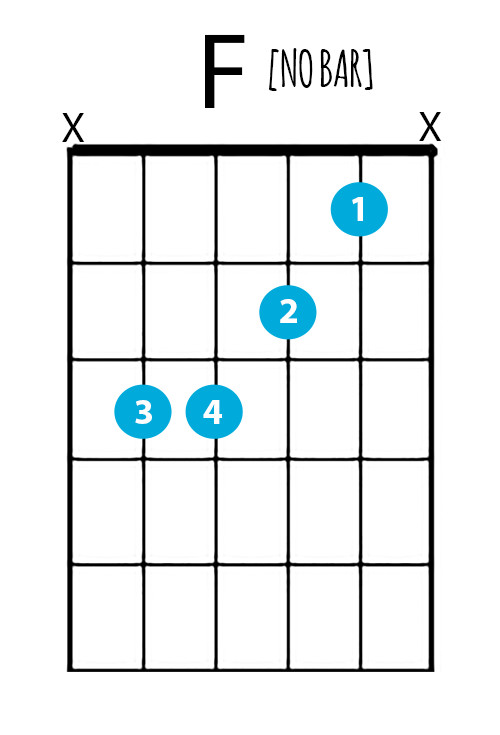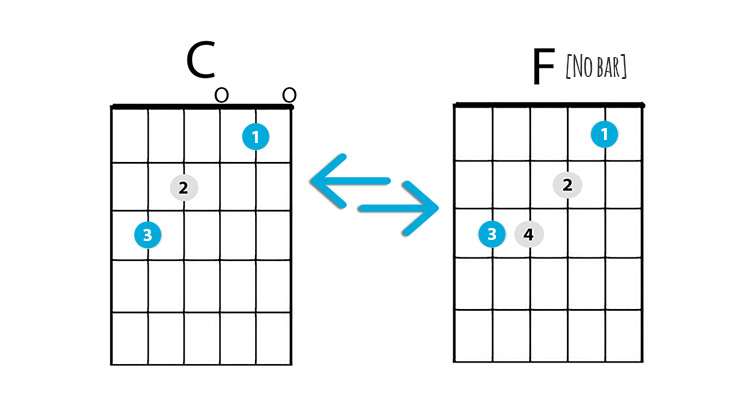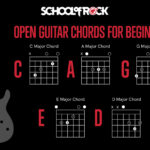Are you struggling with the F chord on guitar? If you’re just starting out, the F chord can feel like a major roadblock. It’s a chord that appears in countless popular songs, making it essential to learn. The good news is, you don’t have to wrestle with the full F barre chord right away! There’s a fantastic, simpler version that sounds great and will get you playing songs much faster.
The F barre chord is often one of the first big hurdles for new guitar players. Among the basic “first position” chords, it’s definitely known as the trickiest. But this easy F chord version bypasses the barre, making it significantly more accessible. In fact, if you already know how to play a C Major chord, you’re almost there! This guide will walk you through playing the easy F chord and give you practice tips to get it sounding smooth in your playing.
What is the Easy F Chord?
The “easy F chord,” sometimes called F major 7 or Fmaj7, is a simplified voicing of the F chord. The main difference is that it doesn’t require you to barre across the fretboard with your index finger. Barre chords can be physically demanding for beginners, as they require strength and dexterity to press down all the strings cleanly. This easy F chord uses fewer fingers and focuses on the core notes of the F major chord, making it much easier to fret, especially when you’re still developing finger strength. It’s a perfect stepping stone to the full barre chord and a great way to immediately expand your chord vocabulary.
How to Play the Easy F Chord: Step-by-Step Guide
Let’s break down how to form this beginner-friendly F chord on your guitar:
- Index Finger: Place your index finger on the 1st fret of the B string (2nd string from the thinnest).
- Middle Finger: Put your middle finger on the 2nd fret of the G string (3rd string from the thinnest).
- Ring Finger: Place your ring finger on the 3rd fret of the A string (5th string from the thinnest).
- Pinky Finger: Finally, place your pinky finger on the 3rd fret of the D string (4th string from the thinnest).
When playing this chord, you’ll only strum the A, D, G, B, and high E strings. Avoid strumming the low E string (the thickest string). Many players find it helpful to gently mute the low E string with their thumb and the high E string with the tip of their index finger to ensure only the correct strings ring out. Alternatively, you can simply focus your strumming to avoid those strings.
 Easy F chord diagram with finger positions
Easy F chord diagram with finger positions
With your fingers in these positions, strum the strings from the D string down to the high E string. Make sure each string rings clearly. If you hear buzzing, double-check that your fingers are just behind the fret and pressing down firmly enough.
Does the Easy F Chord Sound Good?
A common question beginners have is whether this simplified F chord will sound “good enough.” The answer is a resounding yes! While it’s true that it sounds slightly different from the full F barre chord, in many musical contexts, especially when strumming chords in songs, the difference is minimal and often unnoticeable. The easy F chord provides a bright, major sound that fits beautifully in folk, pop, and many other genres.
Think of it this way: it’s a different “voicing” of the F chord. Just like singers have different vocal ranges and tones, chords can have different voicings, which are just different ways of arranging the same notes. Songwriters and guitarists frequently use various chord voicings to add color and interest to their music. The easy F chord is a perfectly valid and musically rich voicing of the F major chord.
Practice Tips: Mastering the Easy F Chord
Knowing how to form the chord is only the first step. To truly master the easy F chord, you need to practice transitioning to and from it smoothly. A highly effective practice technique involves using the C Major chord as a starting point. This is excellent for two reasons:
- Common Chord Pairing: C and F chords are frequently used together in countless songs. Practicing the change between them is highly practical.
- “Common Chord Fingers” Technique: This method utilizes fingers that remain in the same place during chord changes, acting as anchors and making transitions faster and more efficient.
Here’s a step-by-step practice routine:
- Start with a Folk C Chord: Form a standard open C Major chord.
- Move to Easy F: From the C chord, keep your index finger on the B string (it stays in the same place!). Move your middle finger up one string to the G string (2nd fret). Then, add your ring and pinky fingers to the 3rd fret of the A and D strings respectively to complete the easy F chord.
- Anchor Fingers: Notice that your index and middle fingers essentially “pivot” into the easy F chord from the C chord. These are your “common chord fingers.”
- Practice the Transition (No Strumming): Go back and forth between C and easy F chords slowly, without strumming. Focus on the smooth movement of your fingers and building muscle memory.
- Slow Strumming with Metronome: Use a metronome at a slow tempo. Strum the C chord twice, then switch to the easy F chord and strum it twice. Focus on changing chords cleanly and in time with the metronome.
- One Strum Per Chord: Once the two-strum changes feel comfortable, try strumming each chord only once before changing.
- Increase Tempo Gradually: Gradually increase the metronome speed in small increments (e.g., 5 bpm at a time) as you become more proficient.
 Chord diagram showing transition from C to Easy F chord
Chord diagram showing transition from C to Easy F chord
Consistent, short practice sessions (even just 5-10 minutes a day) using this C to F chord change exercise will dramatically improve your ability to play the easy F chord smoothly and confidently.
Moving Towards the Full F Barre Chord
While the easy F chord is incredibly useful and can be used in place of the full F barre chord in many situations, learning the barre chord version is still an important goal for guitarists. The F barre chord is a foundational barre chord shape that can be moved up and down the guitar neck to play other major chords. Understanding barre chords opens up a vast new range of chord possibilities and is essential for playing in different keys and musical styles.
Think of the easy F chord as an excellent stepping stone. By learning it first, you build finger strength and familiarity with the fretboard, making the eventual transition to the full F barre chord much less daunting. Once you can play the easy F chord comfortably, you’ll have a solid foundation to tackle the barre chord and further expand your guitar skills.
If you’re ready to take on the full F barre chord, there are many excellent resources available to guide you. Consider exploring online lessons and tutorials specifically designed to teach the F barre chord step-by-step. With consistent practice and the foundation you’ve built with the easy F chord, you’ll be playing the full barre chord in no time!

